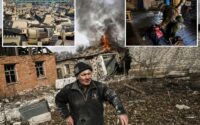Russian missile targets Ukrainian market, killing at least 17
A Russian missile strike killed at least 17 people at a Ukrainian market Wednesday as analysts revealed that nearly 50 elite Russian soldiers died in action as they headed toward a key battleground area.
The outdoor market quickly turned into a blackened ruin Wednesday as sobbing civilians looked for loved ones amid the gruesome scene following the deadly strike in Kostiantynivka, near the front line in the Donetsk region.
At least another 32 people were injured on top of the 17 confirmed fatalities. At least one child is among the dead, officials said.
“There was no military target here,” resident Stefan Slovak said. “This is a peaceful neighborhood in the city center.”
As the resident spoke, charred and mangled bodies could be seen behind him. The attack was one of the deadliest strikes on civilians in months.
First responders rushed to douse flames as some of the bodies were still burning on the ground, according to footage. Wounded civilians were rushed by paramedics into emergency vehicles.

The strike comes as US Secretary of State Antony Blinken announced more than $1 billion in new funding for the war in Kyiv.
Ukrainian President Volodymyr Zelensky called the strike a deliberate attack during a press conference in Kyiv with visiting Danish Prime Minister Mette Frederiksen.
“Those who know this place are well aware that it is a civilian area,” Zelensky said. “There aren’t any military units nearby.”
Moscow had no immediate comment but the Kremlin has constantly denied targeting civilians.

Zelensky said the strike was motivated by his country’s progress on the battlefield.
“Whenever there are any positive advances by Ukrainian defense forces in that direction, Russians always target civilian people and civilian objects,” he said.
Part of Ukraine’s recent success includes killing 49 soldiers of the 7th VDV Division near the settlement of Staromayorske in the eastern Donetsk region amid the Ukraine counteroffensive, according to an update from the Institute of the Study of War.
The think tank cited a Russian military blogger who shared an audio recording Tuesday apparently from a soldier in the Russian 7th Guards Mountain Air Assault Division, in which he claimed that he had to recover the remains of his comrades.
The unidentified soldier complained that “the Russian command is not overseeing the retrieval of bodies and claimed that his unit lost 49 killed in action in one day of fighting.”

The soldier’s comments, according to the think tank’s analysts, suggest that his regiment is still defending Russian positions in western Donetsk and eastern Zaporizhzhia regions, which have seen some of the fiercest fighting in recent months.
The institute added in its update that Ukrainian counteroffensive operations in the Donetsk-Zaporizhzhia border area “are likely succeeding in pinning elements of the 7th Guards Mountain Airborne (VDV) Division” and preventing them from redeploying to critical areas of the front in western Zaporizhzhia.

A prominent Russian source reported last month that members of the elite Russian division were fighting in the area of the strategically important settlement of Robotyne, which Kyiv’s forces claimed to have liberated in late August, marking a gradual intensification of its three-month counteroffensive.
On his fourth secret visit to Ukraine Wednesday, Blinken said that Ukraine’s progress in the counteroffensive is “very, very encouraging.”

“President Biden asked me to come, to reaffirm strongly our support,” Blinken told Ukrainian President Volodymyr Zelensky, fresh off his latest visit to the front lines in Donetsk.
“To ensure that we are maximizing the efforts that we’re making and that other countries are making, for the immediate challenge of the counteroffensive, as well as the longer-term efforts to help Ukraine build a force of the future that can deter and defend against any future aggression.”
After a sluggish start to the counteroffensive, owing in part to Russia’s formidable first line of fortifications protected by sprawling minefields, the Ukrainian military suggested that the subsequent lines of defense might be easier to punch through than the first.

Brigadier General Oleksandr Tarnavskyi, who commands Ukrainian forces in southern Ukraine, said in an interview with The Guardian last week that he expects faster Ukrainian gains as his forces press on a weaker second line of defense.
Tarnavskiy estimated Russia had devoted 60% of its time to building the first defensive line and only 20% each into the second and third lines because the enemy had not expected Ukrainians to break through.
With Post wires


